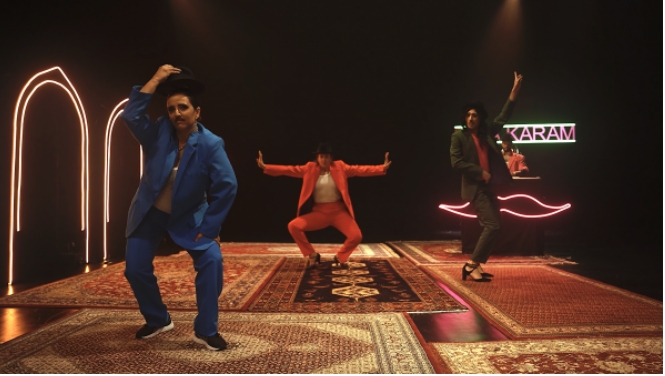Baba Karam – Through Jamileh and Khordadian is based on the Persian dance style baba karam and mixes Persian, Kurdish and Arabic music into a hybridic dance with traces of disco and dance class including queer elements and drag. The show consists of a catchy instruction film, in which you as a visitor and in the intimacy of the sober setting, can dance away in a simple and fun choreography occasionally interrupted by memories and interviews. Concept and idea: Ful (Nasim Aghili, Malin Holgersson, Rani Nair) Setting: Björn Karlsson. Participants: Parwin Hoseinia (Akh Baba), Rani Nair (Raj), Edwin Safari (Jafar the Superstar) and George Chamoun (Rasuul).
The artistic team behind Baba Karam is the group Ful, which consists of the artists Rani Nair (choreographer), Malin Holgersson (interviews) and Nasim Aghili (director and dramatist). Nasim, a Swedish Iranian themself, wishes to direct the light on the American-Iranian dance legends Jamileh and Mohammad Khordadian, whose artistic practices have inspired millions of people around the world to dance.
–What I particularly want to stress in this show is the queer ambiguity that is made visible in their dance and especially in the dance form baba karam. I believe there are many in Tensta who are familiar with baba karam but who might also have a relation to bollywood, dabke, belly dance and disco, says Nasim Aghili.
The artist group Ful is a queer feminist collective who does performances, theater, exhibitions, publications as will as conversation and meetings. Ful was founded in 2008 and consists of activists who analyse norms, theory and forms of knowledge through art, queer feminist ideas, decolonial practises, and post-colonial esthetics as a base. Ful has been active in Sweden and internationally through the art and awarded performances such as Europa Europa and Mödrars Manifest. Ful has been named as one of the introductors of the Swedish gender neutral pronoun “hen” (they/them).
Jamileh is the artistic alias for Fatemeh Sadeghi, one of Iran’s most popular ever performers who popularized belly dance. At the time of the Iranian Revolution and Ayatollah Khomeini’s siege of power, dance became prohibited and she fled to Los Angeles, where she continued performing, preferably for an exile Iranian audience.
Mohammad Khordadian is a choreographer and performer whose dance videos have become enormously popular in Iran. For the Iranian public, he became famous overnight when during a TV-show in 2006, he came out as homosexual. In conjunction with the Iranian Revolution in 1979 he fled to Los Angeles and began his video recordings of dance instructions which were widely spread through private networks in his home country, where dance became prohibited.




